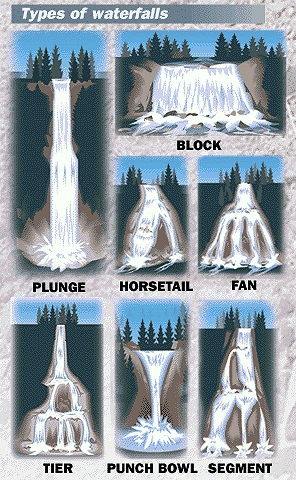The Geological Formation of the Coon
Den Falls
Typically, a river or in this case the Coon Den Branch, flows
over a large step in the rocks which may have been formed by a
fault line. Over a period of years, the edges of this shelf will
gradually break away and the waterfall will steadily retreat
upstream, creating a gorge of recession. Often, the rock stratum
just below the more resistant shelf will be of a softer type,
meaning undercutting, due to splashback, will occur here to form a
shallow cave-like formation known as a rock shelter or plunge pool
under and behind the waterfall. Eventually, the outcropping, more
resistant cap rock will collapse under pressure to add blocks of
rock to the base of the waterfall. These blocks of rock are then
broken down into smaller boulders by attrition as they collide with
each other, and they also erode the base of the waterfall by
abrasion, creating a deep plunge pool.
The Coon Den Branch originates high up on the White Rocks
Mountain and flows from Lacy Trap Ridge. From there, it cuts
through the rock (mostly limestone) and flows over the rock ledge
to form the Falls.
Coon Den Branch becomes wider and more shallow just above
waterfalls due to flowing over the rock shelf, and there is a deep
pool just below the waterfall because of the kinetic energy of the
water hitting the bottom.
The Coon Den falls are one of the highest in the area. Mother
Nature took her sweet time creating this masterpiece. Maybe it was
millions of years?
Which One AM I?
Waterfalls can be classified as to their shape, drop, height and
width. Here is a common classification system: Block-the
water descends from a relatively wide stream or river
Cascade-the water descends a series of rock steps
Cataract-a large waterfall Fan-the water spreads
horizon ally as it descends while remaining in contact with bedrock
Horsetail-descending water maintains some contact with
bedrock Plunge-water descends vertically, losing contact
with the bedrock surface Punchbowl-water descends in a
constricted form, then spreads out in a wider pool
Segmented-distinctly separate flows of water form as it
descends Tiered-water drops in a series of distinct steps of
falls Multi-step a series of waterfalls one after another of
roughly the same size each with its own sunken pool

Some Of The Types
Note: refer to this classification when answering one of the
questions below.
You will be on a well-defined but kind of steep trail to the
falls. Is is about .5 mile but straight. No switchbacks here! You
will follow the stream on your left up to the falls.
Besides taking a semi-tough hike you must do the following to
receive credit for this Earthcache:
1. Email me with the answers to the these questions; A. What is
the type (classification)of this waterfall?, B. Estimate the height
and width (at the base) of the waterfall
2. Post a photo of your GPSr pointing to the base (the one you
used to estimate the width) of the falls. While it would be nice,
you do not have to have to show your face(s) in the photo.
We sincerely hope you have enjoyed your experience of The Coon
Den Falls
This Earthcache was approved by the
Geological Society of America
| We have earned GSA's highest level: |
 |